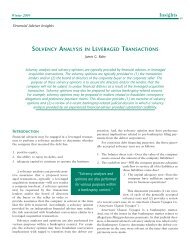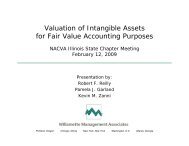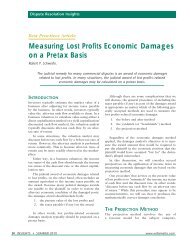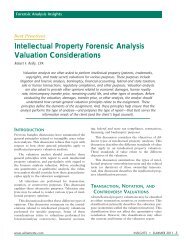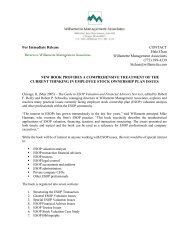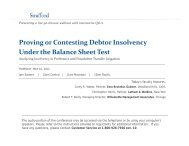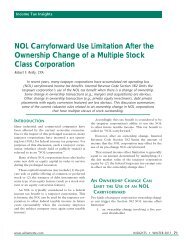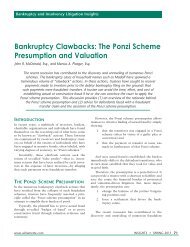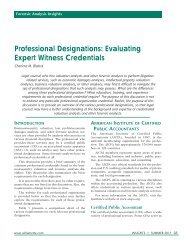View PDF - Willamette Management Associates
View PDF - Willamette Management Associates
View PDF - Willamette Management Associates
- No tags were found...
You also want an ePaper? Increase the reach of your titles
YUMPU automatically turns print PDFs into web optimized ePapers that Google loves.
8% ÷ (1 – tax rate) = the pretax rate. Thecorresponding pretax income capitalizationrate is as follows: 8% ÷ (1 – 33%) =12%. If the analyst applies the 12% pretaxincome capitalization rate to the $120pretax income estimate, Alpha’s businessvalue would still be $1,000 (i.e., $120pretax income ÷ 12% capitalization rate).These last two calculations also answer acommon income approach question: Shoulda valuation be performed on a pretax basisor after-tax basis? As these calculations indicate,the answer is: It doesn’t matter. Aslong as the income measure and thediscount/capitalization rates are adjustedby the same income tax rate, eitherincome approach should reach the same businessvalue.Market ApproachThe market approach is based on theprinciple that a private company can bevalued by referring to pricing guidanceextracted from what investors paid inarm’s-length transactions for comparativeinvestments. The following are commonmarket approach valuation methods:■ Guideline publicly traded companymethod (GPTCM)■ Guideline merger and acquisition transactionsmethod (GMATM)■ Back-solve method.In each of these methods, analystsidentify and analyze market data regardingarm’s-length transactions. Using these data,analysts extract pricing multiples to applyto a private company. These pricing multiplesoften include the following:■ Price to revenue multiple■ Price to book value multiple■■■■■Price to EBITDA multiplePrice to EBIT multiplePrice to pretax income multiplePrice to after-tax multiplePrice to cash flow multiple.An analyst may apply more than onepricing multiple in a market approach analysis,and examine more than one time period.For example, an analyst may derivepricing multiples to apply to the privatecompany financial fundamentals for thesedifferent time periods:■ Latest (trailing) 12 months’ actualresults■■■Next 12 months’ projected resultsThree-year average actual resultsFive-year average actual results.For both the GPTCM and GMATM analyses,an analyst first attempts to identify companiesthat are directly comparable to theprivate company. Such comparable companiesare often about the same size, operatein the same industry or profession, competewith each other, have the same sources ofsupply, or have the same types of customers.Once an analyst can identify such comparablecompanies, the market approach analysisis relatively easy.Of course, an analyst will have to adjustthe financial statements of both the comparablepublic companies and the private companyfor non-operating items, non-recurringitems, differences in accounting principles,and other so-called normalization adjustments.An analyst can often apply thederived mean or median pricing multiples tothe private company’s financial fundamentals.Analysts will typically synthesize (orweight) the various value indications into onemarket approach estimate.It is rare, however, for a valuation analystto identify comparable public companiesfor most private companies. Comparedto most publicly traded or recently acquiredcompanies, the typical private company ismuch smaller, operates regionally, andoperates in a specialized segment of anindustry; therefore, valuation analystsgenerally select and rely on guideline companies.Guideline companies are similarto the private company from an investmentrisk and expected investment return perspective.Guideline companies fit into thesame investment portfolio of companies asprivate companies; that is, investors wouldexpect the same rate and variability ofreturns for all of these companies. Butguideline companies do not necessarily“look like” the subject company.Guideline public company pricing multiplesare more difficult for a valuation analystto apply. It is not reasonable to assumethat mean or median pricing multipleswould automatically apply to the privatecompany, because the selected companiesare not directly comparable. Nevertheless,an analyst can compare a private companyto guideline companies in terms offactors such as relative growth rates, relativeprofit margins, and relative returns oninvestment. From these comparative analyses,an analyst can extract pricing multiplesto apply to the private company’sfinancial fundamentals.The GPTCM is based on an analyst’sconsiderations of guideline public companiesthat trade on national and regionalstock exchanges. Those trading prices andpricing multiples are typically based on relativelysmall trades (i.e., a few thousandshares per trade) of very liquid securities.The GMATM is based on an analyst’sassessment of recent mergers and acquisitionsof entire companies in the privatecompany’s industry. These transactionalprices and pricing multiples are typicallybased on what a strategic buyer is willingto pay to obtain operational control of anoverall business enterprise.The back-solve method looks at historicalsales of stock in the subject company; inother words, an analyst investigates actualarm’s-length sales of company stock anddevelops pricing multiples from thosetransactions. Such transactions typically representsales of small blocks of stock in veryilliquid (private company) securities. Basedon the pricing multiples indicated by recentsale transactions, the analyst “back-solves”the value of the company overall businessusing the techniques described above.As indicated above, different marketapproach valuation methods could all reachdifferent levels of value. The related adjustmentsare summarized in “Levels ofValue” below.Asset ApproachThe asset approach (also called theasset-based approach) is founded on theprinciple that a private company’s equityvalue is equal to the value of the closelyheld corporation’s assets, less the value ofthe closely held corporation’s liabilities. Theasset approach is used less frequently thanthe income approach or the market approachin the valuation of closely held corporationsecurities for the following reasons:■ It is more time consuming and, therefore,more expensive to perform.■ Many valuation analysts do not havethe experience or expertise required tovalue individual assets and liabilities.■ Many valuation analysts are simplyuninformed or misinformed regarding theapplication of this valuation approach.The asset approach is, however,particularly applicable in the following circumstances:■ The company is either capital assetintensive or intangible asset intensive.48JANUARY 2012 / THE CPA JOURNAL



